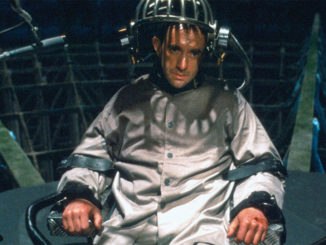
by Kevin Lewis
Sex and politics were never more deliciously displayed than in the legendary Busby Berkeley musicals at Warner Bros., starting with 42nd Street in 1933. Warner Bros. was always one of the most socially conscious studios, creating many films and biographies that questioned social dilemmas and traumas. Its musicals followed suit, and a fluffy musical with an innocuous title, Gold Diggers of 1933 (the second in the Berkeley cycle), contains a mother lode of social comment from characters who are thinly disguised call girls (move over, Brecht and Weill). Joan Blondell and Ginger Rogers honed their wisecracking personas in these musicals; Rogers covered in silver dollars and singing “We’re in the Money” in pig latin, and Blondell avenging the destitute World War I “Bonus Army” veterans with “Remember My Forgotten Man” have become icons of Depression-era movies.
Gold Diggers was released in May 1933, during Franklin Delano Roosevelt’s first term as US President. In March of that year, the month of Roosevelt’s inauguration, the Hollywood studios instituted a 25-to-50 percent pay cut to offset lost box office revenue. Roosevelt had promised a way out of the Depression, but he demanded caps on salaries–– including big Hollywood compensation. In retaliation, the smarting moguls cut salaries for all their craft and creative employees. In June, FDR enacted the National Recovery Act (NRA), which coerced the industry into collective bargaining with its employees. The salary cuts and the NRA––along with the employees’ dissatisfaction with their treatment by the Academy of Motion Picture Arts and Sciences, which was the negotiating agent for the studios––were the impetus for the formation of the Hollywood guilds, including the Society of Motion Picture Film Editors (now the Editors Guild), which transformed the American film industry into a modern labor force capable of shaping its own destiny.
The genius behind these musicals was Berkeley, a former World War I parade drill instructor and Broadway choreographer, who was brought to Hollywood by Samuel Goldwyn to choreograph the newly coined Goldwyn Girls in Whoopee (1930)––which contains Berkeley’s first use of an intricate overhead shot of the designing chorus girls. In these early musicals, Berkeley directed only the musical numbers, which were a seamless collaboration between him, cinematographer Sol Polito, art director Anton Grot, costumer Orry-Kelly and picture editor George Amy. Amy’s collaboration with Berkeley prepared him for the choreographed editing of such diverse films as Yankee Doodle Dandy (1942), for which he received an Oscar nomination, and Air Force (1943), for which he won an Oscar.
Gold Diggers of 1933 was directed by Mervyn Le Roy. The musical numbers were Art Deco architecture and design in motion. The camera movement and editing create a “kaleidoscope of bodies moving,” according to Joanna Ney, film programmer and curator of Dance on Camera for the Film Society of Lincoln Center.
The Berkeley/Warner musicals were highly surrealistic in design, which is especially evident in Gold Diggers’ “Shadow Waltz,” in which 60 violin-playing Art Deco beauties disappear in front of your eyes except for their elegant manicured hands playing the white violins in the dark.
“The Warner Bros. musicals, consciously or not consciously, project a message of the necessity for collectivity––people working together for a common goal; in other words, the New Deal,” explains film historian Elliott Stein, who is the Cinemachat programmer at the Brooklyn Academy of Music. Stein’s movie memorabilia-decorated Paris apartment gave Susan Sontag the inspiration for her classic essay on “Camp,” which revived commercial interest in the Berkeley musicals in the 1960s. “The major popular appeal had to do with the high quality of the musical numbers and their emphasis on the eroticization of the female form,” Stein continues. “The political message was also there, however subliminally. In Footlight Parade [1933], at the end of the ‘Shanghai Lil’ number, the dozens of dancers form a giant mosaic, a sort of jigsaw puzzle, of our country’s leader, FDR, who was helping us emerge from the Depression, followed by the dancers forming the NRA symbol”––perhaps the most unusual way to celebrate government-enacted collective bargaining.
Divorced from politics and the Depression, the films are just as thrilling for a 21st century audience because, as Ney points out, movie audiences are starved for the beauty of the Art Deco sets, the scanty costumes, the bias cut gowns, the choreographed camera movement and the precision-cut editing. Bruce Goldstein, repertory programmer of the Film Forum in New York, characterizes the Berkeley musicals as having a “hand-made look,” and says that today’s movies with computerized special effects don’t thrill him as much. The musicals “take your breath away,” he says. “Gold Diggers of 1933 represents the whole era in one movie because it’s a pre-Code movie and a Busby Berkeley movie.” The movies featured nudity in silhouette and in body shots, which were overlooked until the Hays Production Code was enforced in 1934, and were subsequently edited out for television prints in the 1950s.
The salary cuts and the NRA––along with the employees’ dissatisfaction with their treatment by the Academy of Motion Picture Arts and Sciences, which was the negotiating agent for the studios––were the impetus for the formation of the Hollywood guilds, including the Society of Motion Picture Film Editors [now the Editors Guild].
The national shock over the Depression has been suggested as the reason why audiences demanded violence in gangster movies and frank sensuality in musicals, comedies and melodramas––not to mention Mae West––but these elements were a staple of Hollywood films of the Roaring Twenties under a lax, rarely enforced Hays Code. The Code’s crackdown in 1934 was demanded by the Catholic Church’s Legion of Decency, and enforced beyond the letter of the law by Code administrator Joseph I. Breen. In any case, the so-called pre-Code films were hardly feminist because the female characters were usually gangster molls, call girls or the kept women of corrupt businessmen and/or politicians.
The Berkeley/Warner musicals were highly surrealistic in design, which is especially evident in Gold Diggers’ “Shadow Waltz,” in which 60 violin-playing Art Deco beauties disappear in front of your eyes except for their elegant manicured hands playing the white violins in the dark. (See Jean Cocteau’s 1946 Beauty and the Beast, in which disconnected hands holding lights guide Beauty’s father through the Beast’s darkened palace, and you’ll see the influence of Berkeley.) The camera pans over faces in intricate combinations, close-ups of dripping faces appear before the camera, thighs intertwine with other thighs, bodies morph into the set design and architecture, and overhead crane and traveling shots celebrate an orchestrated orgy of flesh in a dizzy, dazzling kaleidoscope.
Though there are 200-plus dancers, Goldstein points out that “there is almost no dancing” to the classic Harry Warren-Al Dubin songs in the films. For Gold Diggers of 1935, Berkeley created the unforgettable life-and-death nightmare of a New York playgirl in the production number “Lullaby of Broadway.”
Though Berkeley is associated with the Depression movie, he created a second choreographic legacy at Metro-Goldwyn-Mayer for Girl Crazy (1943) and the more memorable Esther Williams musicals, such as the dive into the circle of fire in Million Dollar Mermaid (1951). After years of inactivity, Berkeley had a smashing third act on Broadway in 1971 with No, No Nanette, which reunited him in a swan song with his Warner Bros. dancing star Ruby Keeler.
Apparently, 75 years on, gold-digging call girls are still leaving their mark on politics as we swing headlong into what very well may be another Depression.





